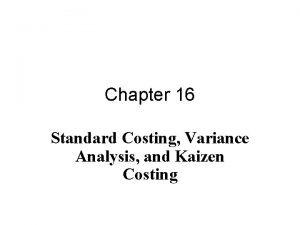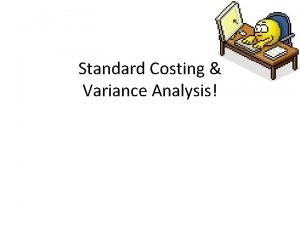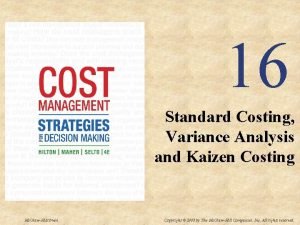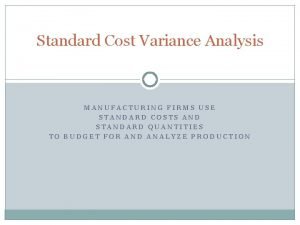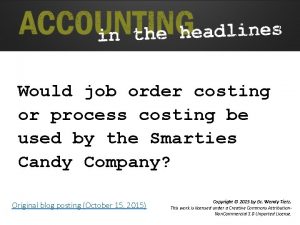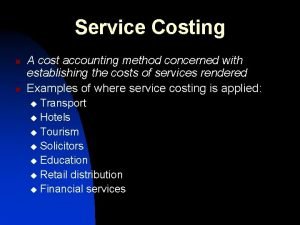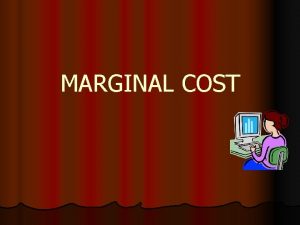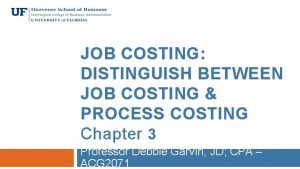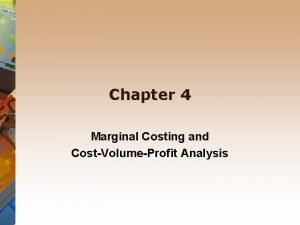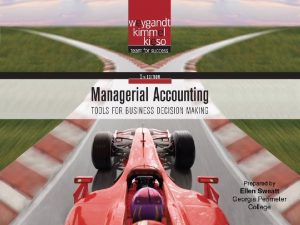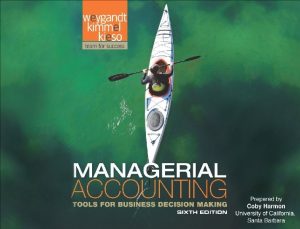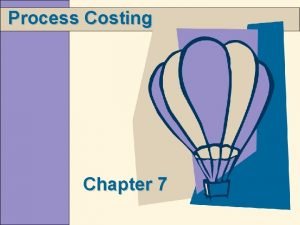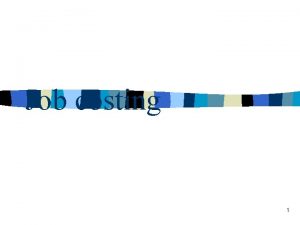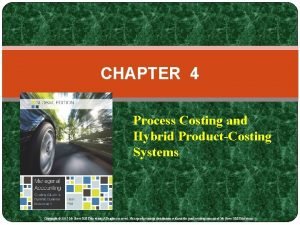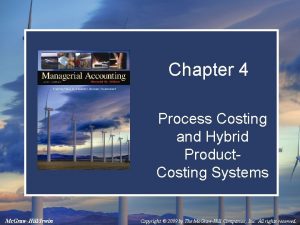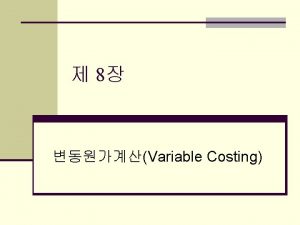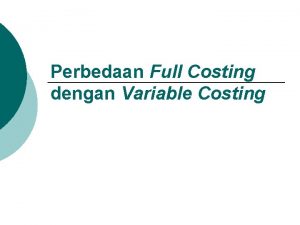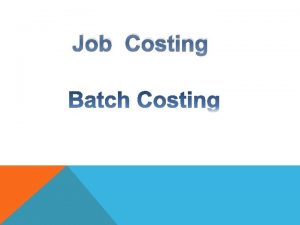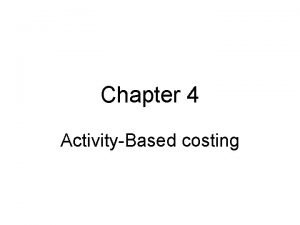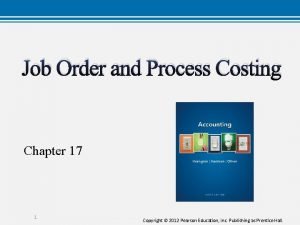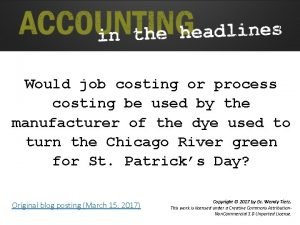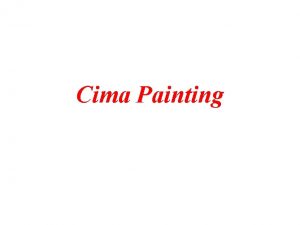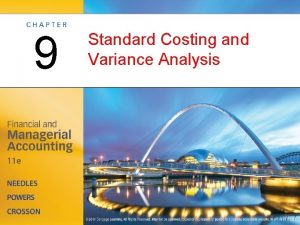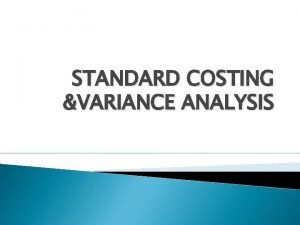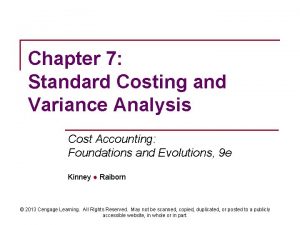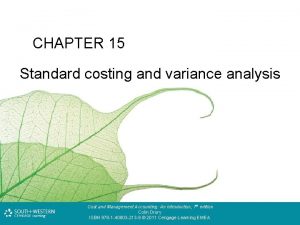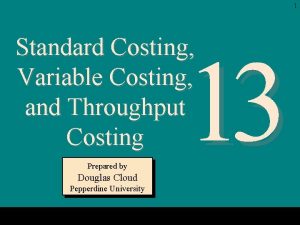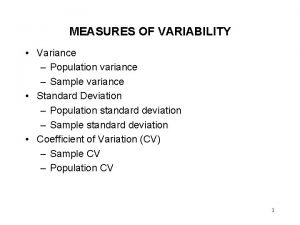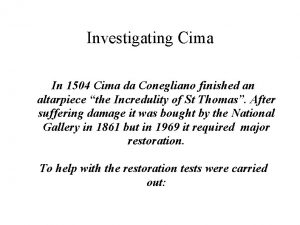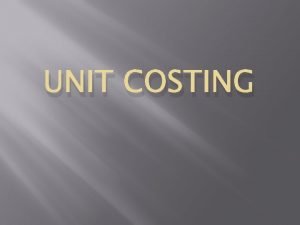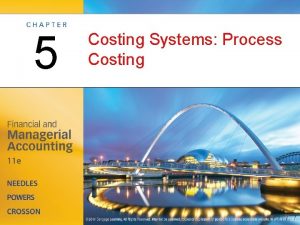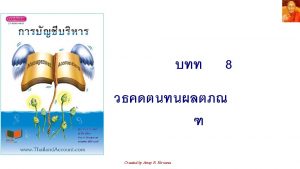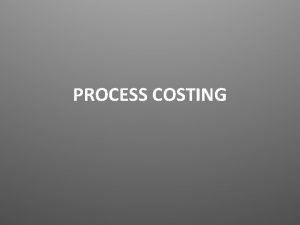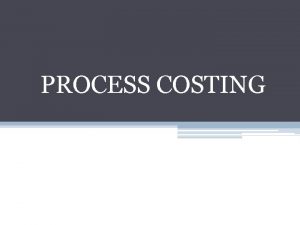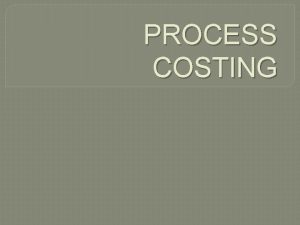Standard Costing Variance Analysis Definitions Standard Cost CIMA




















![Material Mix Variance • Material Mix Variance = [Revised St. Qty – Actual Qty] Material Mix Variance • Material Mix Variance = [Revised St. Qty – Actual Qty]](https://slidetodoc.com/presentation_image_h/ed39dcb149c8673cac69abbd12fba939/image-21.jpg)










- Slides: 31

Standard Costing & Variance Analysis!

Definitions • Standard Cost: (CIMA) “Standard cost is the predetermined cost based on the technical estimates for materials, labour and overhead for a selected period of time for a prescribed set of working conditions. ” • Standard Costing: (CIMA) “the preparation of standard costs and applying them to measure the variations from the actual costs and analyzing the causes of variations with a view to maintain maximum efficiency of the operations so that any remedial action may be taken immediately.

Variance Analysis • Cost Variance: is the difference between the standard cost and the actual costs. • Variance Analysis: is the resolution into constituent parts and the explanation of the variances. v Favorable & Unfavorable Variances. v. Controllable & Uncontrollable Variances

What all could be the reasons for the actual manufacturing cost or the sales/profit to vary from their standard costs and price/profit?

1. Material Variance Types of Variances 2. Labour Variance 3. Overhead Variance 4. Other Variances Material Cost variance Labour Cost Variance Overhead Cost Variance Calendar Variance Material Price Variance Labour Rate Variance Variable overheads Var. Sales Value variance Material Usage Variance Labour Efficiency Variance Variable o/h efficiency var. Sales price variance Variable o/h expenditure var. Sales volume variance Fixed overhead variance Profit Variance Material Mix Variance Material Yield Variance Labour Mix Variance Idle Time Variance

Favorable & Unfavorable Variances • Favorable variances(F) arise when actual costs are less than budgeted costs or actual sales/profit exceed budgeted. • Un favorable variances(U) arise when actual costs exceed budgeted or actual sales/profit are less Profit than Revenue budgeted. Costs Actual > Expected Actual < Expected F U U F

Standard Costs Based on carefully predetermined amounts. Standard Costs are Used for planning labor, material and overhead requirements. The expected level of performance. Benchmarks for measuring performance.

Setting Standard Costs Accountants, engineers, personnel administrators, and production managers combine efforts to set standards based on experience and expectations.

Standards vs. Budgets Are standards the same as budgets? A standard is the expected cost for one unit. A budget is the expected cost for all units.

How will the material price variance and material usage be computed if the quantity purchased is different from the quantity used? The price variance is computed on the entire quantity purchased. The quantity variance is computed only on the quantity used.

Material Cost Variance • Material cost variance arises due to variance in the price of material or its usage. • This can be calculated by using the following formula, • Material Cost Variance = (SQ x SP) – (AQ x AP) , • Where, SQ SP AQ AP = Standard quantity for the actual output = Standard price per unit of material = Actual quantity = Actual price per unit of material • A positive result implies favorable variance and a negative result implies unfavorable variance (adverse variance).

Material Price Variance • Material price variance may arise due to number of reasons like fluctuations in market prices, error in buying due to wrong purchasing policy etc, • This can be calculated by using the following formula, • Material Price Variance = (SP – AP) x AQ • Where, SP AQ AP = Standard price per unit of material = Actual quantity = Actual price per unit of material • A positive result implies favorable variance and a negative result implies unfavorable variance (adverse variance).

Material usage Variance • Material Usage variance is the difference between the actual quantities of raw materials used in production and the standard quantities that should have been used to produce the product, • MUV may arise due to number of reasons like Pilferage of materials , Wastage , Sub-standard or defective materials etc, • This can be calculated by using the following formula, • Material Usage Variance = (SQ – AQ) x SP

Material Mix Variance • MMV is calculated when a product uses mixture of different raw materials, • MMV is that portion of the materials quantity variance, which is due to the difference between the standard and actual composition of a mixture. • It can be represented by the following formula: • Material mix variance = • (Standard cost of actual quantity of the standard mixture – Standard cost of actual quantity of the actual mixture) or (Revised SQ – AQ) x SP

Practical Problems 1. A furniture company uses sunmica tops for tables. It provides the following data: St. Quantity for sunmica per table 4 sq. ft St. price per sq. ft of sunmica Rs. 5 Actual prod. Of tables 1000 Sunmica actually used 4, 300 sq. ft Actual purchase price per sq. ft Rs. 5. 50. Calculate Material variances.


2. From the following information calculate (i) material cost variance (ii) material price variance (iii) Material Usage variance Standard output 100 units Standard Material per unit 3 Ibs Standard price per Ib. Rs. 2 Actual output 80 units Actual price Rs. 5. 50 Actual materials used 250 Ibs

3. From the following information calculate (i) material cost variance (ii) material price variance (iii) Material Usage variance Quantity of material purchased 3000 units Value of material purchased Rs. 9000 St. quantity of raw material req. p. u. 25 units Standard rate of material unit Rs. 2 per Opening stock of material Nil Closing stock of material 500 units Finished production during the period 80 units

4. The standard output of the production house has been set at 1000 pieces per month. However actually 1020 pieces were produced. Following is the data for actual and standard production. Standard Actual Results Usage 1. 5 sq. ft per pad 1. 3 sq. ft per pad Price Rs. 0. 15 per sq. ft Rs. 0. 18 per sq. ft Calculate all material variances.

5. A mfg. concern, which has adopted standard costing, furnishes the following information: Standard: Material for 70 kg. Of finished products 100 kgs. Price of materials Rs. 1 per kg. Actual: Output 210, 000 kgs Material used 280, 000 kgs. Cost of materials Rs. 2, 52, 000 Calculate all material variances.
![Material Mix Variance Material Mix Variance Revised St Qty Actual Qty Material Mix Variance • Material Mix Variance = [Revised St. Qty – Actual Qty]](https://slidetodoc.com/presentation_image_h/ed39dcb149c8673cac69abbd12fba939/image-21.jpg)
Material Mix Variance • Material Mix Variance = [Revised St. Qty – Actual Qty] x St. Price Rev. St. Qty = St. Qty of 1 Mat. x Actual Total Standard Total

From the following information regarding a standard product, compute 1. Mix 2. Price 3. Usage Variance:

From the following information regarding a standard product, compute 1. Mix 2. Price 3. Usage Variance: Standard Material Qty. Rs. p. u. Actual Total Qty Unit Price Total A 4 1. 00 4. 00 2 3. 50 7. 00 B 2 2. 00 4. 00 1 2. 00 C 2 4. 00 8. 00 3 3. 00 9. 00 Total 8 7. 00 16. 00 8. 50 18. 00

Material variances Labour Variances • • Labour Cost Variance Labour Usage/Efficie. Var Labour Rate Variance Idle time Variance SH*SR – AH*AR (SH-AHactual)*SR (SR-AR)* AH SR*Idle time

Practice Problem A firm gives you the following data: Standard time per unit 2. 5 hours Actual hours worked 2, 000 hours Standard rate of pay Rs. 2 per hour 25 % of the actual hours has been lost as idle time. 2 LUV 2000 F Actual output 1, 000 units St. Rate St. Hrs 2500 LPV -500 U Actual wages Rs. 4, 500 Actual Rate 2. 25 Calculate all labour variances. Actual Hrs 2000 Idle time 500 ITV 1000 F LCV 500 F

Practice Problems Compute the Labour variances from the information given below: Standard time 3 hours per unit Standard rate of wages Rs. 6 per hour Actual production 700 units Actual time taken 2000 hours 6 Actual Wages Rs. 14000 St. Rate St. Hrs 2100 Idle time 50 hours Actual Rate 7 Actual Hrs 2000 Idle time 50 LUV 900 F LPV -2000 U LCV -1400 U IDV 300

Labor Efficiency Variance- Causes Poor quality materials Poorly trained workers Unfavorable Efficiency Variance Poor supervision of workers Poorly maintained equipment

Responsibility for Labor Variances You used too much time because of poorly trained workers and poor supervision. I am not responsible for the unfavorable labor efficiency variance! You purchased cheap material, so it took more time to process it.

Overhead Variances • Overhead variances arise due to the difference between actual overheads and absorbed overheads. The estimate of budget of the overheads is to be divided into fixed and variable elements. i. e. 1. Variable overhead variances. – Variable overhead budget or expenditure variance, and – Variable overhead efficiency variance. 2. Fixed overhead variances.

Formulas 1. Variable overhead variances. (Standard variable o/h for actual prodn. – Actual variable o/h) 2. Variable overhead budget or expenditure variance, (Budgeted variable overhead for actual hours – Actual variable overhead) i. e. AH*BR – Actual Cost 3. Variable overhead efficiency variance. Standard variable overhead rate per hour [Std. hours for actual output – Actual hours] i. e. (SH-AH) *SR 4. Fixed Overhead Variance Budgeted FO- AFO

Sales Variances • Sales Margin Price Margin = (AP-BP)*AQ • Sales Margin Volume variance = (AQ-BQ)*BC • Total Sales Margin variance = AQ*AC – BQ*BC
 Standard costing formula
Standard costing formula Material usage variance = material mix variance +
Material usage variance = material mix variance + Difference between standard costing and variance analysis
Difference between standard costing and variance analysis Material price variance
Material price variance Standard cost is
Standard cost is Difference between standard costing and kaizen costing
Difference between standard costing and kaizen costing Dawson toys ltd
Dawson toys ltd Management accounting
Management accounting Companies that use job order costing
Companies that use job order costing Job-order-costing-vs-process-costing
Job-order-costing-vs-process-costing Difference between service costing and product costing
Difference between service costing and product costing Absorption costing vs marginal costing
Absorption costing vs marginal costing Job costing vs. process costing
Job costing vs. process costing How to find manufacturing overhead
How to find manufacturing overhead Contract costing definition
Contract costing definition Variable costing vs absorption costing
Variable costing vs absorption costing Assumption of cvp
Assumption of cvp Abc costing vs traditional costing
Abc costing vs traditional costing Job order vs process costing
Job order vs process costing Abc costing vs traditional costing
Abc costing vs traditional costing Process costing and hybrid product-costing systems
Process costing and hybrid product-costing systems Process costing and hybrid product-costing systems
Process costing and hybrid product-costing systems Activity based costing vs job costing
Activity based costing vs job costing Hybrid costing example
Hybrid costing example Hybrid costing system
Hybrid costing system Marginal costing and absorption costing
Marginal costing and absorption costing Perbedaan full costing dan variable costing
Perbedaan full costing dan variable costing Job costing vs batch costing
Job costing vs batch costing Target costing and activity based costing
Target costing and activity based costing Job order costing vs process costing
Job order costing vs process costing Metode full costing dan variable costing
Metode full costing dan variable costing Job costing with process costing
Job costing with process costing
